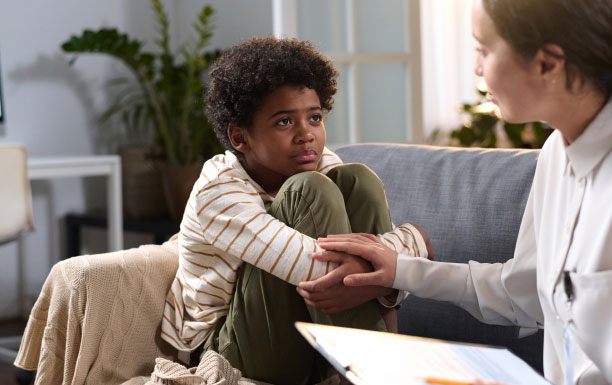Therapy for Anxiety

We treat children and teens with a variety of anxiety related problems. Some common anxiety problems for children and teens involve separation anxiety, generalized anxiety, or social anxiety.
Separation Anxiety
Involves developmentally inappropriate and excessive fear about separation from their parents or other close adults.
Examples of common symptoms:
- Getting anxious getting ready for school, refusing to go to school or expressing anxiety about being separated from one’s parent throughout the day while at school
- Expressing fears that something bad will happen to one’s parent or caregiver
- Clinging to a parent at home, needing to be in the same room with a parent at home, always wanting to know where a parent is at, refusing to go to bed without a parent present, needing to sleep in the same room as a parent
Generalized Anxiety Disorder
Involves excessive worrying about a range of everyday events and difficulty controlling the worry. Children and teens suffering from generalized anxiety are often described as “worriers”.
In addition to worry and trouble controlling worry, children and teens with generalized anxiety may have:
- Trouble sleeping related to worry
- Trouble concentrating related to worry
- Somatic symptoms such as headaches or stomach aches
Social Anxiety Disorder
Involves an intense fear of being negatively evaluated, embarrassed, or humiliated in social settings. This can manifest in some school situations, like speaking in front of others, or in a range of social situations interacting with other youth and adults.
Examples of symptoms of social anxiety in children and teens:
- Being anxious about answering questions in class or presenting in front of the class
- Being anxious about going to a friend’s house, or having friends over
- Being anxious about talking to other children or teens
- Being anxious about being observed performing in front of other people (for example, giving a speech at school, performing music or in a play, or performing in sports)
- Avoiding social situations
Therapy for Anxiety
Dr. Philip Kendall is an NIH grant award winning researcher who has developed two separate manualized treatments for separation anxiety, generalized anxiety, and social anxiety that we use at Teleios Behavioral Health.
The Coping Cat manual was developed for children ages 7 to 13. This workbook uses a “Scaredy cat” as a vehicle for learning to deal more effectively with anxiety. The cat in the workbook changes from a scaredy cat to a coping cat over time. The C.A.T. manual is used with teenagers ages 14 to 17.
Both treatment manuals teach children to distinguish anxiety from other feelings and to recognize their physical reactions to being anxious. Then, youth are taught to identify the thoughts and self-talk that they have in anxiety provoking situations, and to use more adaptive self-talk to cope in those situations. For children younger than 7, we typically adapt the Coping Cat manual for their presenting problems.

